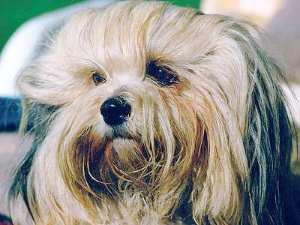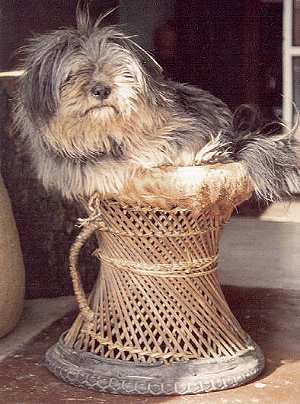The Unofficial
Tibetan Lhasa Apso Standard
This
"standard" was an attempt to write a modern version
of the original 1901 standard of Lionel Jacobs. It
incorporates what
we know to be true of modern Himalayan landrace stocks, as well as what
we can see in the old photographs of Apsos of nearly 100 years ago.
January,
1998
In judging
the Lhasa Apso, strongest consideration
should be given
to breed
characteristics which fit it for survival
in Tibet.
General:
Originating in the Himalayas and high plateau of Tibet,
the Lhasa Apso is a small, long-haired dog, well adapted to extremes of
climate and altitude. He presents a rectangular outline due to a slight
shortening of his extremities, but otherwise is a sound, normal canine
in construction, with a natural topline, and a smooth efficient gait.
His
original purpose as an indoor sentinel requires him to be alert,
independent,
and discriminating toward strangers.
Character:
Gay and assertive, but chary of strangers.
However, the Apso's intitial mistrust of strangers should not be
confused
with timidity or fearfulness.
Size:
About l0 in. to a maximum of 11 in. height at shoulder
for dogs, and about 9.5 in. to a maximum of 10.5 in. for bitches.
Head:
Distinctly terrier-like, skull narrow, not quite
flat, but not domed or apple shaped. Fore face of fair length, strong
in
front of the eyes. The planes of the top of the skull and the top of
the
muzzle are parallel. The stop is moderate, not well defined or
indented.
The muzzle is about 4 cm in length, measured from a point at the
midline
between the medial corners of the eyes to the end of the nose, or one
third
of the total length of the head measured from occiput to nose tip. A
Square muzzle is objectionable. The
nose leather is large and prominent, not depressed, with large open
nostrils.
The nose should be black.
Mouth:
The jaws should be quite level. Owing to the level jaws,
the dental occlusion may be level, reverse scissors or scissors. Both
overshot
and marked undershot are undesirable. Six incisors in both upper and
lower
jaws are desirable. Incisors are set in a very slight curve, to allow
for
normal occlusion of the canines.
Ears:
Pendant, set on somewhat below the crown of the head, heavily
furnished with hair.
Eyes: Almond
in shape, neither very large and full nor very small
and sunk, dark brown in color. The eyes appear to be placed more
frontally
than in most breeds, owing to an alteration in the shape of the malar
bone
(cheekbone) exhibiting an almost "human"
expression. Noticably
light eyes should be penalized.
Front and rear
assemblies: Shoulders should be set well back
on the body and parallel to the sides of the body, and laid back at a
normal
canine angle, namely about 60 degrees with respect to the horizontal
axis.
The sternum is well developed for the muscular attachments of the neck
and shoulder. The pelvis is normally angled for a canine which carries
its tail over the back - that is not so steep as to present a low tail
set, but not flat or tipped up. Angulation front and rear should be
moderate
and balanced fore and aft.
Body:
There is a tendency in all breeds to look for a level top
and a short back. The Lhasa Apso body should not be too short; it
should
be noticeably longer than the height at the withers, but still
compact.
There should be a very slight arch at the loin to provide strength, and
the the dog should be well ribbed up, with a strong loin and well
developed
quarters and thighs.
Legs and Feet:
The fore legs should be straight. However, in
all short legged breeds there is a tendency to crookedness, but the
straighter
the legs the better, so long as there is no sacrifice of substance.
There
should be good bone. Owing to the heavy coat the legs look, and should
look, very heavy in bone, but in reality, the bone is medium, neither
heavy
nor fine. It should be rounded and of good strength right down to the
toes.
The hocks should be well let down. Feet should be round and catlike,
with
good pads.
Tail:
Should be carried well over the back while on the move.
At rest, or when surprised or unhappy, the dog may lower the tail.
Coat:
Should be heavy, of good length and very dense. There should
be a strong growth on the skull, falling on both sides. The legs should
be well clothed right down to the toes. In general appearance the hair
should look hard, straight and strong with no tendency to
curl. The
coat should have weight, so that when picked up and released it should
fall immediately into its original position. Cottony, silky
or woolly
coats should be penalized. Coat should be judged on the basis
of
quality, not on excess length or grooming.
Color:
All colors carrying black nose pigmentation are
acceptable. Traditionally, dark tips on beard and ears are considered
an
asset.
Faults: Any
deviation from the above to be penalized to the degree
it deviates.
Some Modern Tibetans
 Meet Chu-Chu, owned by friends of mine in Switzerland. This is a bitch
recently imported from Bhutan. Her great-great grandfather was
bred
by the previous king of Bhutan, and was pictured on one of that
country's
postage stamps. Note the expression - so similar to Le, one of
the
original foundation imports. She stands a little under 10 inches
at the shoulder, and is noticably longer than tall. She has a
beautiful
almond eye, and a fairly long muzzle. Her bite is
scissor.
Her coat is hard and straight.
Meet Chu-Chu, owned by friends of mine in Switzerland. This is a bitch
recently imported from Bhutan. Her great-great grandfather was
bred
by the previous king of Bhutan, and was pictured on one of that
country's
postage stamps. Note the expression - so similar to Le, one of
the
original foundation imports. She stands a little under 10 inches
at the shoulder, and is noticably longer than tall. She has a
beautiful
almond eye, and a fairly long muzzle. Her bite is
scissor.
Her coat is hard and straight.
 These three beauties are "gompa Apsos" from a line of dogs originally
obtained
from Tibetan refugees years ago. Mrs. Mumta Khanna and her mother
and daughters have been breeding this line of Apsos for 30 years in New
Delhi, in northern India. They have the same almond eyed, terrier
type faces as the original imports to the West, and are very similar in
type to the Bhutanese, Chu-Chu pictured above. Again note the
hard,
straight coats. Mrs Khanna reports that her males are generally
not
more than 10 inches high at the shoulder, and her females not more than
9 inches as a rule. Most of the dogs have level bites, some
reverse
scissor, some scissor.
These three beauties are "gompa Apsos" from a line of dogs originally
obtained
from Tibetan refugees years ago. Mrs. Mumta Khanna and her mother
and daughters have been breeding this line of Apsos for 30 years in New
Delhi, in northern India. They have the same almond eyed, terrier
type faces as the original imports to the West, and are very similar in
type to the Bhutanese, Chu-Chu pictured above. Again note the
hard,
straight coats. Mrs Khanna reports that her males are generally
not
more than 10 inches high at the shoulder, and her females not more than
9 inches as a rule. Most of the dogs have level bites, some
reverse
scissor, some scissor.

This
photo was taken in Bhutan recently. This handsome gentleman is
guarding
his 80 year old Tibetan mistress' shop. He is 15 years old in
this
photo. In spite of the cropped coat and lack of grooming, we can
still see the wonderful expression and the super coat texture. He
has the significant muzzle length and large nose leather of the typical
Tibetan Apso. The dog has a scissor bite, but obviously has level
jaws, as can be seen by the finish of the muzzle.
 Meet Chu-Chu, owned by friends of mine in Switzerland. This is a bitch
recently imported from Bhutan. Her great-great grandfather was
bred
by the previous king of Bhutan, and was pictured on one of that
country's
postage stamps. Note the expression - so similar to Le, one of
the
original foundation imports. She stands a little under 10 inches
at the shoulder, and is noticably longer than tall. She has a
beautiful
almond eye, and a fairly long muzzle. Her bite is
scissor.
Her coat is hard and straight.
Meet Chu-Chu, owned by friends of mine in Switzerland. This is a bitch
recently imported from Bhutan. Her great-great grandfather was
bred
by the previous king of Bhutan, and was pictured on one of that
country's
postage stamps. Note the expression - so similar to Le, one of
the
original foundation imports. She stands a little under 10 inches
at the shoulder, and is noticably longer than tall. She has a
beautiful
almond eye, and a fairly long muzzle. Her bite is
scissor.
Her coat is hard and straight. These three beauties are "gompa Apsos" from a line of dogs originally
obtained
from Tibetan refugees years ago. Mrs. Mumta Khanna and her mother
and daughters have been breeding this line of Apsos for 30 years in New
Delhi, in northern India. They have the same almond eyed, terrier
type faces as the original imports to the West, and are very similar in
type to the Bhutanese, Chu-Chu pictured above. Again note the
hard,
straight coats. Mrs Khanna reports that her males are generally
not
more than 10 inches high at the shoulder, and her females not more than
9 inches as a rule. Most of the dogs have level bites, some
reverse
scissor, some scissor.
These three beauties are "gompa Apsos" from a line of dogs originally
obtained
from Tibetan refugees years ago. Mrs. Mumta Khanna and her mother
and daughters have been breeding this line of Apsos for 30 years in New
Delhi, in northern India. They have the same almond eyed, terrier
type faces as the original imports to the West, and are very similar in
type to the Bhutanese, Chu-Chu pictured above. Again note the
hard,
straight coats. Mrs Khanna reports that her males are generally
not
more than 10 inches high at the shoulder, and her females not more than
9 inches as a rule. Most of the dogs have level bites, some
reverse
scissor, some scissor. 